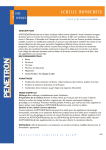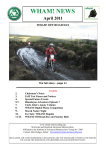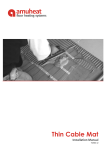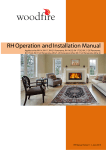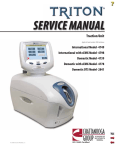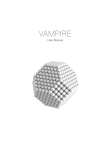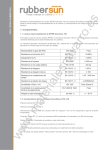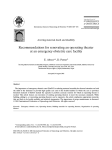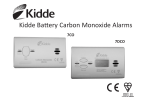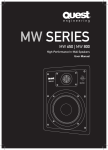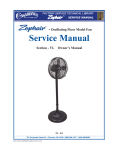Download Building a composting toilet, #142
Transcript
PHOTO: LYNDA WILSON 18 • TOB 142 • August/September 2007 Building a composting toilet In TOB 141, we featured Steve Howard’s earthen compound design dwelling. Steve shares the details of the construction of the composting toilet with us. BY STEVE HOWARD The toilet was the first structure built on the block. In fact, it was the first building project I had ever done. As it was to act as the site toilet as soon as possible, some things were rushed and there were plenty of mistakes made along the way. Council approval The plans for the composting toilet were submitted at the same time as the overall dwelling plans. While happy with the plans and that I knew how to operate it safely, the councils concern was with ongoing upkeep of the system, in the event that I sold the property. I suggested that I create a user manual for the system, a copy of which would be kept by council. This satisfied their concerns on that matter, and construction could go ahead. However, this was back in 2001, and restrictions may have tightened since then. a bit bulgy, so at least it matches in with the earth walls of the other buildings. Cement slurry was later applied to the outside of the pit for aesthetic reasons, as each batch of plaster dried to a different colour. Structural framework I dug the holes for the stirrups, on which the cypress poles sit, next. Somehow I managed to get one of the holes in the wrong spot, so the whole building is askew. I still don’t know how I managed that, but it created some interesting angles for eaves etc! The five main poles were each almost 3.5m high and about 250 mm in diameter, making them the heaviest objects that I had to manoeuvre in the whole building process to date – approx 100 kg. Each pole had to be raised on its stirrup, plumbed, marked out, lowered, drilled, raised again and plumbed again. This was all done single handedly, which is where lots of clamps and patience were required. A water level was then used to mark the final level for each pole, which was then cut using a chainsaw whilst standing on top of a ladder – I was very glad when that was over!! The floor is marine ply laid on cypress bearers and joists, which progressed fairly easily once the out of square poles had been allowed for. The roof is stick built from cypress. The door is hand made from cypress and the fixed windows have cypress frames/ jambs, which I glazed myself. The roof is covered in Zincalume. The toilet boxes are built of plywood, covering a cypress frame. The plywood is built up with papier-mâché under the toilet seat, providing a tight seal for the standard Pit construction The pit was built first – I wired together the reinforcing mesh for the slab, the sides and roof of the pit, then poured the slab with concrete mixed in a barrow. The ferroconcrete sides required a few layers of cement/sand plaster – hessian and old chook wire were first stapled to the reinforcing mesh, and the bolts to hold the access panels were also wired in beforehand. The ferroconcreteing was tedious and I would definitely use concrete blocks if I were to do it again. The whole effect is A couple of mates helped with the balustrade – on the left is Monty who came over from England for three weeks just to help me build! TOB 142 • August/September 2007 • 19 Left: Seat is usually left down to help create a seal. The condensation tube returns moisture to the pit. Bucket contains chaff. Top right: Removing the access panel (left pit) exposes the baffle & aeration pipes (right pit). Rest: the toilet at various stages of construction. plastic toilet seat. A plastic lining joins the toilet seats down to the pit. Papier-mâché walls After the roof was up I nailed old chook wire to the frame and used hoop iron to brace the structure. I then started using a cement slurry/newspaper papiermâché that I had tested successfully on the horizontal – but it failed miserably and I eventually ripped it off. This is the only bit of the buildings that I have had to demolish and redo. I then started using newspaper and Bondcrete for the papier-mâché and that worked well initially, although it was still very time consuming. This remained untreated, but after about a year sitting in the sun the Bondcrete contracted, causing gaps beside the poles. This dragged the jamb from the bottom of one of the windows, cracking the glass. The walls were eventually covered in Zincalume externally. The internal walls had hessian tacked on, which was petrified with several coats of limewash and then painted. Finishing touches The flues are made from 100 mm PVC pipe and joiners, with clear plastic tube used to drain condensation from the flue to prevent it re-entering the pit. Whether this is necessary is debatable, as during the hot, dry summers we experience around here, I sometimes have to add water to the pit to keep the moisture level high enough. The flues were painted black above the roof to help airflow. 20 • TOB 142 • August/September 2007 The stairs were then made from concrete blocks over a concrete slab, with preformed concrete riser/treads. The balustrade is cypress posts concreted in the ground, with the corrugated Zincalume infill. The inside of the pit was finished off with a few coats of Bondcrete for waterproofing and a couple of coats of black paint (so you cannot see as much when you look into the pit down the toilet). The aeration pipes were formed by splitting 90mm PVC pipe lengthwise – they are attached at one end to a bent nail which is attached to an offcut of plywood liquid-nailed to the ferroconcrete walls. The other ends fit into holes cut in the fibre cement baffles. The access panels are also made from fibre cement, with ventilation panels formed by 10mm wire mesh over flywire (to keep insects and mice out of the pit). A few friends assisted with the final stages – thanks to Keith for the guttering and eaves, and to Monty and Peter for helping with the balustrade. Hindsight The building of the composting toilet basically went ahead according to the plans with the following exceptions: • the walls were changed from wattle and daub, due to my concerns about movement of the structure in the wind, and were initially constructed from papier-mâché • the Bondcrete contracted in the sun after about a year; the walls were then covered externally with corrugated iron, and internally with petrified hessian • the toilet chutes are rectangular rather than round for ease of construction • the ventilation flues were moved slightly to one side to avoid the ridge in the roof insect screen 900 SECTION 1:20 150mm Ø PVC cypress trusses Zincalume ridge cap Zincalume cypress battens 540 cypress framing fixed pane wooden “wattles” lime plaster min. 12mm verandah posts min. 150mm Ø cypress “daub” min. 30mm 1700 cypress handrail and balusters toilet seat fibre cement wattle and daub 50mm gap 400 1000 50 x 25 cypress frame rubber seal min. 100mm gap 100 cypress joists 180 cypress bearers 1000 airtight draped to shed condensation seal into pit 180 composting pit 180 access panel 5mm fibre cement 180 screed to 30mm baffle 5mm fibre cement 180 galvanised post support 100 min. 200 Ø cypress 10mm 100mm thick slab screed F82 reinforcing aeration pipes 100 Ø PVC cut in half ledges to hold and placed aeration pipes upside down in place ground to fall away at minimum 1:20 slope internal depth 180 200 x 200 x 300 concrete 400 x 400 x 300 concrete PROJECTION COMPOSTING PITS 1:20 1100 lip 50 high and 50 wide for attaching rubber seal from toilet 500mm internal diameter for hole 50mm ferrocement F82 reinforcing 50 internal height brass bolts embedded in concrete for attaching access panels 20mm ledge to position baffle Volume of each pit = 1.39 m3 screed 30mm at edges to hold any liquid 900 slab 100mm past pits 10mm ledge to position access panel 20mm ledge to position baffle 100mm thick slab F82 reinforcing 50 1400 50 slab extended 300mm further for ease of maintenance internal width TOB 142 • August/September 2007 • 21 Composting Toilet Manual This is an extract of some of the information provided in the ‘user manual.’ The full manual can be downloaded from The Owner Builder website (www.theownerbuilder.com.au > Extracts > #142 Composting Toilet). • I should have placed the light lower on the walls, thereby keeping the pit in shadow – it currently shines down into the pit • the handrail on the stairs and balcony was filled in with corrugated iron to satisfy building regulations – and I like the look too, which is a bonus! Overall I would say the toilet looks very good from the outside, and its height and different method of construction adds interest to the compound. However, if I were to build it again I would make the pit, and possibly the walls of the toilet room, of concrete blocks for ease of construction. Although I like the look and ease of the corrugated iron walls, it would be more stable as one structure, rather than one building perched delicately on top of the pit. I What I would do differently 1. As I mentioned, I would make the whole structure from concrete blocks. 2. I would put a side access panel for placing food scraps in without having to enter the toilet. 3. The front face of each toilet box would slope back in under the seat towards the floor, making it easier to get off the seat. How does it Work? The composting toilet works by taking human waste and other organic wastes and providing an environment in which bacteria, fungi and worms can decompose them as quickly and completely as possible, with minimal side effects. It is important to realise that the toilet is a living process. Most of the wastes are converted into carbon dioxide, water vapour and other gases, which are expelled through the flue, leaving behind the compost that is only a small fraction of the original volume of the wastes deposited. In many ways the compost pit is like a slow burning fire, with the compost like the ash left over after the wood has been converted to smoke. Won’t emptying the pit be disgusting? When we imagine the pit we think of a wet mixture of faeces and toilet paper, smelling of ammonia, just like a pit toilet. However, after the pit has aged for a year the compost that results is dry and crumbly with a slightly sweet earthy smell, just like ordinary compost. There is no faeces, toilet paper or any other waste visible. What can go into the toilet? Basically anything that the bacteria, fungi and worms can eat, and which won’t kill them, can be added to the pile. This is basically anything that was once alive. The most common additions to the pile are: faeces, urine, toilet paper, straw, sawdust, shredded newspaper, grass clippings, kitchen scraps, leaves, garden waste, meat, dust, lint, kitty litter, disposable nappies (with plastic backing removed), sanitary pads, tampons, cold ashes, twigs, hair. It is important to note that faeces should only contribute about 20-25% of the material being added to the pile. What cannot go into the toilet? • Urine from anyone on antibiotics or the pill. • Non-organic substances such as glass, metal and plastic, as the bacteria, fungi and worms cannot eat them. • Chemicals, antiseptic and antibiotics that will kill the bacteria, fungi and worms. • Leaves or sawdust containing natural hormones or resins that stunt growth eg. pine, eucalyptus and cypress. • Large quantities of liquid that will drown the bacteria, fungi and worms. • Large quantities of paper or print that can contain toxic dyes. • Large quantities of grass clippings that will compact and become impervious. • Large quantities of any one material, as they will take a long time to decompose. • Hot material such as cigarette butts and hot ashes as they may cause a fire. Available at newsagents Australia wide peter garrett lifestyle 2007 Over 5000 green businesses, organisations, products and more Build Your Own House www.byohouse.com.au the light at the end of the tunnel is green… the planet we inhabit kylie kwong organic food tastes better Owner builders helping each other helen razer showdown in aisle 7 Need to find baby products, kids clothing, an organic snack? Here’s your ultimate guide to green! tim flannery www.greenpagesaustralia.com.au 22 • TOB 142 • August/September 2007 changing climate from your own backyard The #1 website for owner builders Ask questions on our interactive online forum Record your O.B. project online for FREE Composting Toilet Manual Page 1 How does it Work? The composting toilet works by taking human waste and other organic wastes and providing an environment in which bacteria, fungi and worms can decompose them as quickly and completely as possible with minimal side effects. It is important to realise that the toilet is a living process. Most of the wastes are converted into Carbon Dioxide, Water Vapour and other gases and expelled through the flue, leaving behind the compost that is only a small fraction of the original volume of the wastes deposited. In many ways the compost pit is like a slow burning fire, with the compost like the ash left over after the wood has been converted to smoke. It is important to note that faeces should only contribute about 20-25% of the material being added to the pile, for reasons listed below. The remainder of the bulk should be household and garden wastes. The composting processes within the pit are exactly the same as those that occur in a garden compost pit. There does however need to be a greater degree of control of the composting process and later sterilisation so that: • The final material is free of all pathogens and parasites. • No offensive odours are encountered either within the toilet or outside. • The human waste is not obvious when using the toilet. • Decomposition occurs quickly and completely. The end product after sterilisation is a good soil amendment, with the Nitrogen converted into forms much more readily accessible by plants (nitrites, nitrates and ammonia). Doesn’t it smell and look awful? Will it smell? If all the measures given below are followed then there should be an earthy smell, with no ammonia or rotten egg gas smells. Given that the ventilation draws air down through the toilet seat the smell is actually less than when using a flush toilet, where smells enter the room until the toilet is flushed. What causes it to smell? The toilet will only smell if there is excess nitrogen (so add high Carbon materials) or if the pile is too wet (reduce the moisture levels as outlined above). If ventilation is completely blocked there may be insufficient oxygen, but this would be very rare. Keeping human waste covered with soil, wood ash and high carbon waste also helps. Do I have to look at the waste? The pit is black on the inside and there are no lights that shine into the pit, so that the waste is not obvious. Won’t emptying the pit be disgusting? When we imagine the pit we think of a wet mixture of faeces and toilet paper, smelling of ammonia, just like a pit toilet. However after the pit has aged for a year the compost that results is dry and crumbly with a slightly sweet earthy smell, just like ordinary compost. There is no faeces, toilet paper or any other waste visible. How do I use the Toilet? When using the toilet it is useful to keep in mind that everything you do is an attempt to provide the bacteria, fungi and worms with food, water and a comfortable environment in which to live. All the following advice is simply the best way to keep them in good health. Do’s • Provide the bugs with a good home, with plenty to eat and drink. • Keep the lid down and the door closed. • Put in human waste, toilet paper and household and garden wastes. • Keep the moisture level, C:N ratio and pH level as required (see below). • Add a tin full of wood ash, soil and high Carbon materials to the pit after each use. • Control the insects living in the pit. • Ensure ventilation works well. • Only clean toilet with soap and water. Co pyrig ht - The O wner Bu ilde r ( #14 2 Augu st/ Septe mb er 200 7) a nd Ste ve Ho wa rd ww w.the owne rbu ilde r.com.a u, 02 4 982 8 820 (Aus tral ia ) Composting Toilet Manual Page 2 Don’ts • Don’t allow the conditions in the pit to become unfriendly to the bacteria, worms or fungi. • Don’t put in anything that will either kill the organisms, that they cannot eat or that will cause a fire in the pit. • Don’t allow pathogens to come into contact with soil, water, humans, insects or rodents. What can go into the toilet? Basically anything that the bacteria, fungi and worms can eat and which won’t kill them can be added to the pile. This is basically anything that was once alive, with some limited exceptions listed below. The most common additions to the pile are: faeces, urine, toilet paper, straw, sawdust, shredded newspaper, grass clippings, kitchen scraps, leaves, garden waste, meat, dust, lint, kitty litter, disposable nappies (with plastic backing removed), sanitary pads, tampons, cold ashes, twigs, hair. It is important to note that faeces should only contribute about 20-25% of the material being added to the pile, for reasons listed below. What is the best way to put them into the toilet? When adding material to the pile keep the following points in mind: • The bacteria, fungi and worms operate best in material that is damp, not soggy, so the material being added should be neither too wet nor dry. If material is to be added which is too wet or dry then either add more dry material with it or add water. • The materials being added should contribute to a Carbon:Nitrogen ratio of about 30:1 and have a neutral pH, as shown in later sections. • The composting process is most efficient when the materials are well mixed, so add only a small amount of material at any time. Adding a tin full of organic matter after each use of the toilet and then the occasional addition of other material is the best way to add to the pile. Large quantities of any one material will take a long time to decompose. • Smaller particles compost more quickly than larger ones, so break wastes up if they are too large. Bones and thicker branches will not decompose quickly enough and should be left out of pile. • In general the greater variety of material that can be added the better. What cannot go into the toilet? • Urine from anyone on antibiotics or the pill. • Non-organic substances such as glass, metal and plastic as the bacteria, fungi and worms cannot eat them. • Chemicals, antiseptic and antibiotics that will kill the bacteria, fungi and worms. • Leaves or sawdust containing natural hormones or resins that stunt growth eg. Pine, eucalyptus and cypress. • Large quantities of liquid that will drown the bacteria, fungi and worms. • Large quantities of paper or print that can contain toxic dyes. • Large quantities of grass clippings that will compact and become impervious. • Large quantities of any one material, as they will take a long time to decompose. • Hot material such as cigarette butts and hot ashes as they may cause a fire. How do I start a new pile? When a new pile is to be started place a few bricks at the bottom of the pit and lay some plastic mesh over the top of them – this will provide good ventilation to the base of the pit. On top of the mesh place a layer of organic wastes at least 200mm thick, comprising straw, grass clippings, old compost and soil. It is important that this material will not compost quickly as it is a refuge for the worms in case the pile above becomes too hot during decomposition. This starter pile needs to absorb excess moisture until the pile grows, and also provide the bacteria, fungi and worms to the pile to start the composting process. During the early stages of a pile monitor the liquid level, and add more dry materials or urinate elsewhere until the problem is corrected. The pile is most vulnerable to shocks (excess liquid in particular) when it is small. What sort of worms should I use and where do I get them? The best worms for the job are manure worms, such as tiger and blue worms – basically any worms from worm farms. Garden worms will not do the job as they require different conditions. So long as there are still worms in the old pile then it is simplest to transfer worms to the new pit before it is sterilised. Co pyrig ht - The O wner Bu ilde r ( #14 2 Augu st/ Septe mb er 200 7) a nd Ste ve Ho wa rd ww w.the owne rbu ilde r.com.a u, 02 4 982 8 820 (Aus tral ia ) Composting Toilet Manual Page 3 What happens when the pit is full? When the pile is getting towards the top of the pit or just when you want to finish with one pile then the pile should be covered in as much other organic waste as will fit into pit to help ensure all human waste is covered and well composted. How do I sterilise the compost? The full pit should be left for at least six months but preferably until the other pit is full, to complete composting and to age. The pit should be emptied early in the morning during hot summer weather so that flies are at a minimum and also that during sterilisation the compost can reach temperatures that will kill all pathogens and parasites. The ground outside the access panels should be covered in straw or grass clippings for insulation then covered in black vapour barrier. The compost should then be shovelled over it, then more vapour barrier placed over the top. The sides should be folded over and the whole covered in clear polycarbonate sheeting and with sides suitably covered to keep the air around the compost hot. Bricks or other weights should be placed over the top to hold everything in place. Straw or other insulation can be placed over the top at night for insulation. The compost is to be left in place until the internal temperature has been measured at above seventy degrees Celsius for at least 3 hours. The compost can then be removed and used as desired. Before the compost is sterilised it should not come into contact with skin, eyes, mouth etc, and care should be taken not to touch eyes, mouth or nose until the hands have been cleaned. Clothes and tools used should be sterilised as an extra precaution – just put them in black plastic with the compost. The area around the pits must be cleaned of any spills. What happens if the pile dries out? If the toilet is left unused for some time, eg over Christmas holidays, the pile may have dried out and thus be impervious to water. The best solution is to add lots more organic material to the top of pile and add water to make it quite moist – the pile will absorb the moisture and return to normal. The bacteria, fungi and worms should reactivate but in severe cases may need to be reintroduced. How do I clean the toilet? It is important that no chemicals that will kill bacteria etc be used to clean the toilet in case they enter the pit. The insides of toilet chute should simply be washed with soap and water using a brush. Can I use the urine separately? Urine is acidic and high in salts and may carry disease if the donor is sick. If used separately it should be diluted to 1 part urine to 5 parts water, with a little agricultural lime (not hydrated lime) added to neutralise the pH. Why do I have to do these things? The above advice makes more sense when we look at the living requirements of the bacteria, fungi and worms that are required to decompose the human and other wastes. It is important to note that there are two types of decomposition that can occur – aerobic (with oxygen) and anaerobic (without oxygen). The composting toilet should be managed so that aerobic decomposition occurs as it is quicker and does not smell as much, and also because worms require these same conditions. What conditions are required for decomposition to be aerobic? 1. Moisture level – the pile should be damp, but not soggy, so that there is enough water to sustain life but not so much that water fills all gaps, thus excluding oxygen. The moisture level can be controlled by any or all of the following: • Controlling the moisture level of material entering the pile. • Controlling ventilation to increase or decrease evaporation. • Adding water as necessary (though generally no liquids other than urine should be added). • Adding dry material as necessary. • Controlling the temperature of air entering pit. • During high use periods more dry material should be added to soak up excess liquid, especially when the pile is small. Co pyrig ht - The O wner Bu ilde r ( #14 2 Augu st/ Septe mb er 200 7) a nd Ste ve Ho wa rd ww w.the owne rbu ilde r.com.a u, 02 4 982 8 820 (Aus tral ia ) Composting Toilet Manual Page 4 2. Carbon : Nitrogen Ratio - bacteria need about 30 parts Carbon (for energy and growth) for every 1 part of Nitrogen (for protein synthesis and growth). Human waste has more Nitrogen than required, so other materials with higher Carbon levels need to be added to balance the pile. If the material in the pile has more Nitrogen than required there will be excess ammonia produced, and less importantly more oxygen will be needed for decomposition. If the pile has too much Carbon added then decomposition will be very slow and when the compost is applied it will rob the soil of Nitrogen so that decomposition can be completed. In general add small amounts of high Carbon materials (eg. Sawdust, chaff, straw, rice husks) with wood ash or dirt after each use of the toilet with a variety of other household and garden wastes added at other times. The exact ratio is not essential and need not be calculated, but should be kept in mind if problems are noticed. 3. Temperature - the temperatures that are experienced within the pile in this climate are generally suitable for decomposition to continue, given the heat generated by decomposition and the insulating affect of the pile itself, and are thus not an area of concern. The worms should have a cool section within the starter pile in case hot aerobic compost results from material added to the pile while it is small. Note that due to the gradual addition of materials and constant airflow the temperature of the pile will not be sufficient to sterilise the compost. 4. Acidity - bacteria and worms are best suited to neutral pH, which is best achieved by using a variety of materials in the pile. Since Nitrogenous materials such as human waste are generally acidic (creating a sour smell) it is possible to add agricultural lime (not hydrated lime) to sweeten the pile, but by no means is this necessary. Avoid adding large quantities of materials that are especially acidic or alkaline eg. Pine leaves, citrus. 5. Oxygen Level - given adequate moisture level (and thus air gaps), worm activity and ventilation then the oxygen level will be more than sufficient and is thus not an area of concern. Ventilation control is provided by the design of the toilet. Turning the pile should only be considered as a last resort. How is disease prevented? The toilet is potentially a great health hazard if the following conditions are not met. How is disease transmitted from the pile to people? Pathogens can be transmitted directly to drinking water, from food grown in infected soil, from touching or working infected soil, by insects or rodents accessing pile and spreading pathogens, or by poor hygiene practices while handling pre-sterilised compost. What has to be done to prevent transmission? • Compost must be kept separate from soil and water. The construction of the pit will separate the contents from soil and groundwater and contain all liquids from the pile, while external drainage must prevent surface water entering pit then washing out. • The pit must be constructed and maintained to keep compost safe from insects and rodents. How can pathogens and parasites be reduced and killed? • Leaving the compost to age for at least one year will significantly reduce pathogens and parasites – numbers are reduced by a lack of food and competition and predation by other organisms. • Heating the entire pile to at least 65 degrees Celsius for at least 20 minutes will kill all pathogens and parasites. Note that these temperatures will not be reached within the pit under normal use as shown in this manual, and the compost must be sterilised as outlined above. What do I do about insects in the pit? • Insects enter the pit with the organic materials that are added. Efforts must be taken to reduce their numbers and keep them within the pit for both health and aesthetic reasons. • Insects are best controlled by keeping the pile covered by high Carbon materials such as sawdust etc. Mild insecticides as used in greenhouses can be used as a last resort, but care needs to be taken that they do not kill beneficial organisms. Co pyrig ht - The O wner Bu ilde r ( #14 2 Augu st/ Septe mb er 200 7) a nd Ste ve Ho wa rd ww w.the owne rbu ilde r.com.a u, 02 4 982 8 820 (Aus tral ia ) Composting Toilet Manual Page 5 What do I do about liquid building up under the pile? It is best to keep moisture within the pile, as it evaporates more quickly due to the higher temperatures and larger surface area. The solution is to add more dry materials to the pile to absorb the moisture and increase ventilation, while temporarily urinating elsewhere may be an option. Adding extra dry materials before periods of high use is a useful precaution, particularly when the pile is small. Note that the liquid is usually ‘compost tea’ rather than urine unless the pile has dried out and become impervious to moisture. How does the structure work? Ventilation • Air is admitted at the bottom of the access panel to help evaporate any liquid which has developed below the pile and to help aerate the bottom of the pile. The flap is used to reduce the flow of air if required. An extra inlet can be cut into each panel if required. • The baffle is designed to prevent the pile sagging and blocking the flow of air from the inlet in the access panel. It also supports the aeration pipes. Holes are cut so that air can reach the base, the middle and the sides of the pile as well as flow over the top. It is essential for good evaporation that air can bypass the pile so that it does not have to strain its way up through the pile. • The aeration pipes are designed to help get oxygen into the middle of the pile and to help evaporation within the pile. They also help break the pile up and prevent it packing down into one lump. • The bricks and plastic mesh are designed to allow good airflow to the base of the pile to allow any liquid that develops there to be evaporated more quickly. • The toilet seat should be airtight when closed, and when opened air should be gently drawn into the pit, not sucked out of it bringing odours into the room. • The flue must be of a larger size than the inlet so that it will draw air down through seat when it opens. The flue must extend well beyond roof to draw well, and be painted black to help it draw in still weather. Condensation on inside of flue must be diverted away from pit, with the condensation diverter kept clear so that it drains well. The flue exits near the seat so that it helps evaporate any condensation that develops on the seat. Ventilation Problems If air and/or insects are sucked into the room from the toilet then we need to reverse the air pressure by any or all of the following: cleaning flue and insect screen of spider webs and dead insects, ensuring cap on top of flue is preventing downdrafts, increasing height or width of flue, checking for breakages, blockages or disconnection in flue, installing fan in flue, checking seal on toilet seat, checking rubber seal, closing windows, doors or vents in room, turning off exhaust fan in rooms if applicable, checking toilet and pit for cracks. General 1. The pit must be constructed to prevent insects and rodents from entering. • All vents are screened and covered in wire to prevent insects and rodents from entering. • All gaps are weather sealed. • The gap between the pit and the floor is bridged with a rubber seal to prevent entry and also to direct waste and condensation onto pile rather than onto top of pit. The seal must be constructed of a material that is black and that will not break down in contact with urea. • The structure must be durable enough not to crack or corrode or in any other way expose compost to the elements. 2. External drainage must be maintained to keep surface water away from the pit. 3. The apron must be smooth and easily cleaned of spills after emptying the pits. 4. Potential future additions include a light in pit to heat it during winter, insulating the pit, a fan in the flue for better ventilation (widen flue around it to allow natural ventilation when it is off) and a flue and vents in the room to bring more fresh air in. Co pyrig ht - The O wner Bu ilde r ( #14 2 Augu st/ Septe mb er 200 7) a nd Ste ve Ho wa rd ww w.the owne rbu ilde r.com.a u, 02 4 982 8 820 (Aus tral ia )













